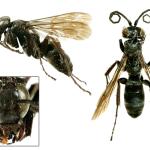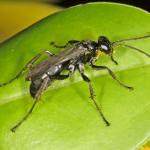Widespread in Britain and Ireland. There are records from the Isle of Man, the Isles of Scilly and from the Channel Islands.
In Europe, this is essentially a northern and central species. The range extends eastwards across the Palaearctic to the Pacific coast. It is also known from the Nearctic (Wolf, 1972).
This species is not regarded as being scarce or threatened.
Day, 1988 is the standard work for identifying British Pompilidae. Wiśniowski, B., 2009 is also useful.
Members of the subgenus Anoplius (to which A. nigerrimus belongs) are generally associated with wet habitats. However, A. nigerrimus is more often associated with dry grassland and scrub. Males are often found running over low vegetation (M Edwards, pers. comm.).
Probably univoltine; May to September.
Spiders of various genera within the families Lycosidae, Gnaphosidae and Pisauridae have all been reported as prey (Day, 1988).
This species nests in a variety of situations such as under stones, in hollow plant stems, deserted aculeate burrows and snail shells. It is also able to construct its own burrow and cell in friable soil (Richards & Hamm, 1939). One nest of four cells was found under a stone on moorland at an altitude of 400 m in Glen Tilt, near Blair Atholl, East Perthshire (M Edwards, pers. comm.).
This wasp has been found on wild carrot.
No information available.
1998




